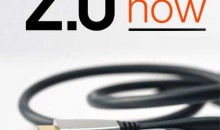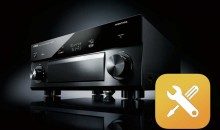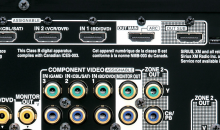HDMI 2.0 Compatible and HDCP 2.2 or Interim 4K
As HDMI 2.0 compatible receivers were announced to much fanfare, more and more products started coming to market with the feature, we noticed something unusual: This HDMI 2.0 “compatibility” designation. It was unusual because the chips used weren’t HDMI 2.0 from the get-go but rather HDMI 1.4. They promised HDMI 2.0 compatibility with a firmware upgrade…but they didn’t promise “all-encompassing HDMI 2.0. At the same time, 4K support was being widely touted, and the whole industry seemed on the move to bring forth 4K-supporting products that could handle the latest 4K UHD (Ultra HD) video signals and make use of the newest displays now hitting the market. Indeed, this seemed to be the crux of the “HDMI 2.0 compatible” marketing push. But HDMI 2.0 and HDCP 2.2 are not all that they’re purported to be—at least not yet.
HDCP stands for High-bandwidth digital Content Protection. It’s the content protection system that makes it difficult to copy the pure digital file either streamed or stored on physical media. It does this by creating a “handshake” between the transmitting and receiving system. In order for it to work, all devices in the signal path need to be able to speak the same language (using the same HDCP version). The new HDCP 2.2 version was needed to address the particular differences involved in UHD 4K resolution video streams.
The Problem with HDMI 2.0 Compatible Products
A whole host of AV receivers shipped this year touting they were HDMI 2.0 compatible, but this is different from saying they are using fully-compliant HDMI 2.0 chips. Rather, this compatibility has to do with the support of some level of 4K resolution and the ability to handle larger data through the pipeline—a requirement for sending 4K over a single HDMI cable to a compatible display. Another factor affecting these HDMI 2.0 “compatible” devices is that they are not inclusive of the HDCP 2.2 copy-protection system required to transmit future 4K content. It’s not really their fault, though, since the chips with both technologies don’t yet exist. You can get the Silicon Image SiL9679, but it only supports a 4:2:0 color space—and it’s currently the only game in town. 4K is supposed to support up to 4:4:4 (not that there’s any content deployed in that format yet), but users will have to wait for that. All new UHD displays are using these SI chips in order to have anything that will pass 4K at all. They lack one important ingredient, however, HDCP 2.2.
The Problem with HDCP 2.2
As mentioned above, HDCP needs to complete a “handshake” in order to function. If any device in the chain doesn’t support HDCP 2.2, the handshake doesn’t occur and you don’t get the goods. That means that any content delivered with HDCP 2.2 (currently there is none, by the way) won’t get to any TVs not using HDCP 2.2. If we’re talking about sources, a Blu-ray encoded in HDCP 2.2 won’t play back on any devices not also using HDCP 2.2. It might get hung up at the display, or it may get stopped athlete intermediate sounder or AV receiver. Welcome to the big problem of HDCP 2.2: there are currently no products supporting both HDMI 2.0 and HDCP 2.2—and you need both in order to support the future 4K content that will stream over the air and via 4K Blu-ray. Unfortunately, HDCP 2.2 chip availability is very thin, and it is lagging behind products and HDMI 2.0 chips by a wide margin.
Firmware Upgrades Can’t Add HDCP 2.2
Unlike the firmware upgrades that are supposedly facilitating HDMI 2.0 functionality on some AV receivers, you can’t get HDCP 2.2 without an actual chipset. You need the actual chip, and manufacturers, in a rush to market with some 4K support, aren’t waiting around.
Why You May Not Need to Worry
While this all sounds like a bit of a cluster, the truth is that 4K isn’t exactly steamrolling through our living and theater rooms anytime soon. Sure, displays are coming out in droves, but the dearth of actual 4K content belies a greater and more significant issue. Bandwidth requirements for 4K will keep broadcasters wary of pushing too hard too fast, and 1080p isn’t getting any complaints. On top of that, most consumers aren’t clamoring for 4K content as a whole and most aren’t seeing enough 4K to drum up the excitement that brought about the relatively rapid deployment of 1080p and Blu-ray.
If you have a 4K display, everything will work fine for now. Backwards-compatibility means that your HDCP 2.0 and HDCP 2.1 devices will play nice and you’ll get all of that up conversion you were promised. The only incompatibility you’ll face will (potentially) be with pure HDCP broadcast of Blu-ray content that demands both HDMI 2.0 and HDCP 2.2 in order to make the handshake. For now, that seems a bit far off. Given the value of today’s receivers and the likelihood that true 4K content sourcing is still quite a ways off from mainstream, only the earliest adopters should hold off and wait for HDCP 2.2-compatible receivers. For the rest of us, the current features and values being offered on the market are hardly anything to say ‘no’ to, and the fields are ripe for picking the low-hanging fruit.







Clint, what’s the date of this article? I don’t see any dates on the article, and I assume that the January responses are in January of 2015. How about adding dates to articles, especially articles about technology in flux, when the actual date of the writing might matter quite a lot?
Thanks!
I echo Ernie Gilman’s comment. Increasingly, I am finding articles on technology and associated equipment without any dates. This is ridiculous. Without knowing the date of the article sentences like, “It’s not really their fault, though, since the chips with both technologies don’t yet exist.” and “You can get the Silicon Image SiL9679, but it only supports a 4:2:0 color space—and it’s currently the only game in town.”, have no context. It is only with a date that such information becomes meaningful. Who is editing this stuff? Come on!!
What about the Onkyo tx-nr838? Does it have actual HDMI 2.0 and HDCP 2.2? Are there limitations? What receiver would you recommend if I want HDMI 2.0, HDCP 2.2, Atmos and full band 4k/60fps
The Onkyo TX-NR838 has the Silicon SIL 9679 chipset, which supports HDMI 2.0 and HDCP 2.2, but only 4:2:0 colour band-width. Some people would like to see it support 4:4:4 colour band-widthm, but easy now, this will not be a standard on Consumer electronics. As the 4:4:4 band-width would challenge the 18 Gbps data capacity on HDMI 2.0 to the max.
Wait if it is important for you to cover 4:4:4 in 4K, I believe this will never be implemented in consumer products like AVR, but only be used in Studios and Broadcast production
OK, my company has a problem. In 2015 we purchased a Marantz SR5009 4K receiver from one of our suppliers for an existing customer upgrade for when affordable 4K projectors would become available. This month we installed a BENQ HT8050 4K projector and the 4K Bluray disc set of The Revenant. We are using a Samsung 4K Blu-ray player, an existing Spectrum HDVR cable box, and a Key Digital 4K HDMI from the receiver to the projector. Great picture, however occasionally the video from both cable and 4K Blu-ray player disappear and we’re left with what looks like a raster pattern (snow).on screen. When we switch back to the previous video source we get a great picture, and then switch back to the original that was lost and we get a great picture. So, what’s going on? is it the fact that we just discovered that the SR5009 turns out to be 2.0, and possibly as low as 1.4 from what I’m reading in this article, while the 4K Blu-ray and HT8050 are both 2.2?
What can be done? Is there an upgrade 2.2 4K chip that can be installed in the SR5009?